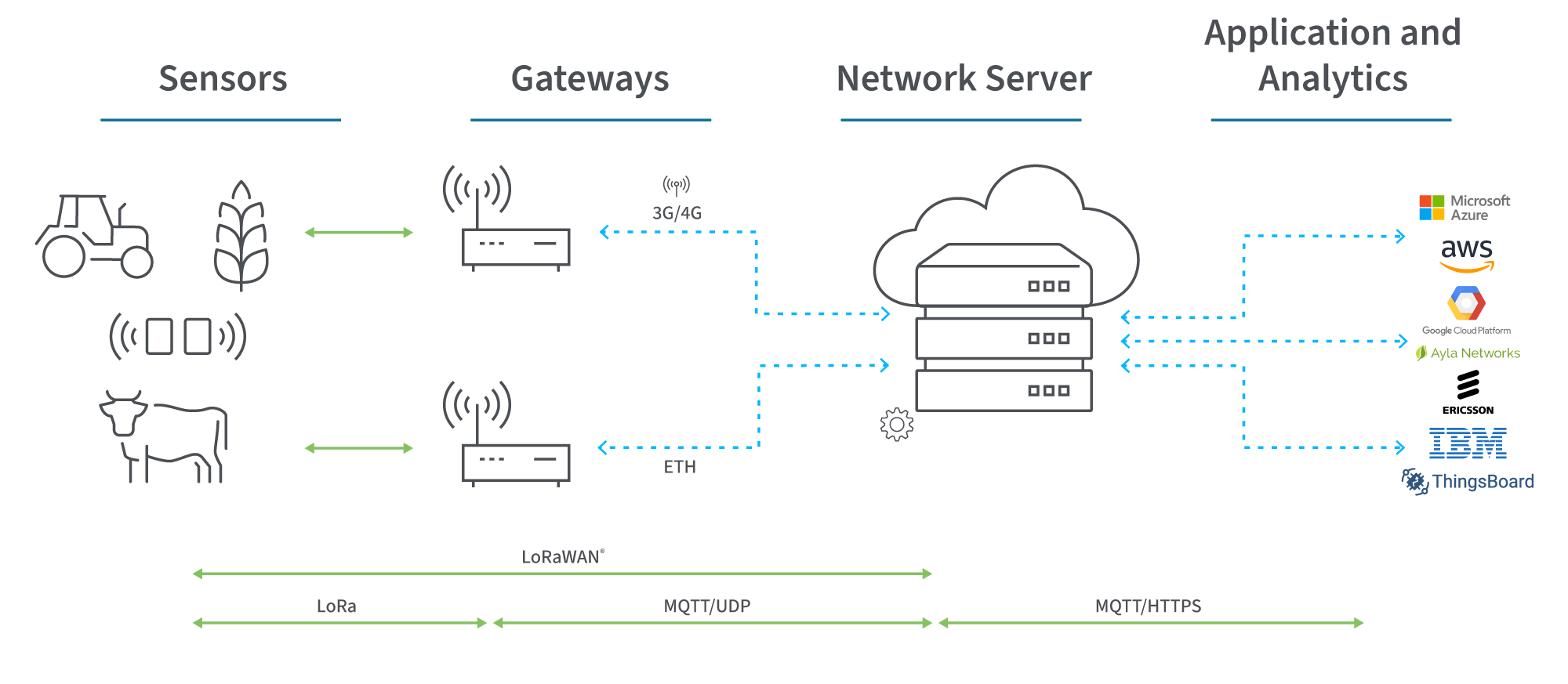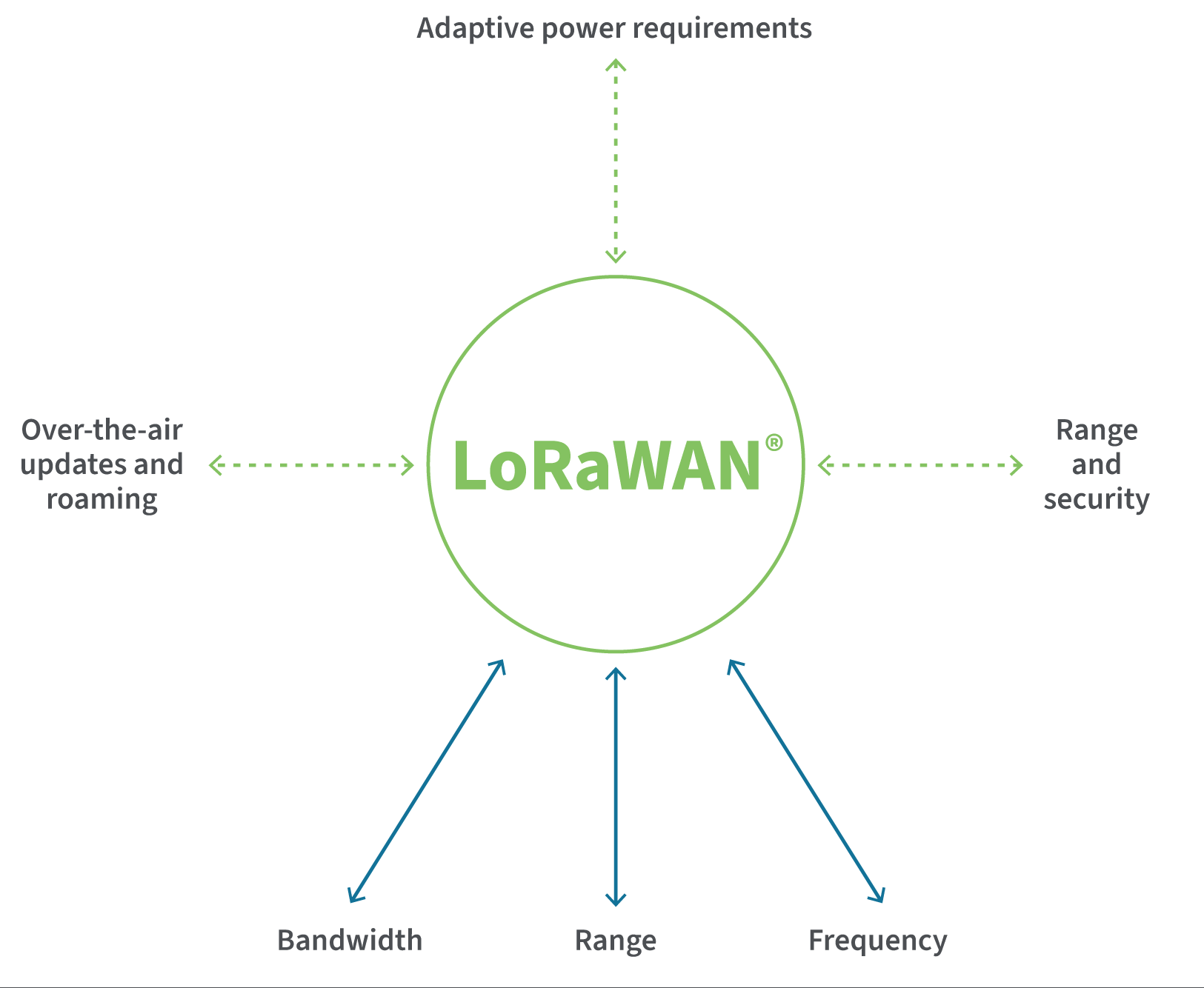LoRa vs LoRaWAN: The Evolution of LoRa Technology
The LoRa Alliance® started in 2015 to support the global adoption of the LoRaWAN standard. The term LoRaWAN refers to a low power wide area network that controls how the LoRa signal from sensors communicates across the network. LoRa stands for long range and uses the spread spectrum radio modulation technique. LoRa modulation first started in 2010 by the French company Cycleo for encoding data in radio waves and later bought by Semtech.
What Is LoRa?
LoRa Explained
Originally developed for adding wireless communication capabilities for the utility metering industry, the LoRa protocol operates in an unlicensed radio spectrum with data rates up to 253 kB/s and is prized for its ability to send tiny amounts of data over long distances while requiring extraordinarily little power.
What Is LoRaWAN?
LoRaWAN technology consists of a low-power, wide-area network protocol built onto LoRa modulation useful for securing dependable bi-directional IoT communications. The LoRaWAN protocol provides end-to-end encryption to deliver advanced security features at scale. With LoRaWAN ranges reaching up to ten miles, this technology supplies a more economical choice compared to cellular technologies in remote areas.
How LoRa and LoRaWAN Work in IoT
In LoRa modulation, a chirp signal spreads the signal spectrum. By increasing the chirp rate, the signal spreads over a range of frequencies allowing it to travel farther without error. As a result, the LoRa communication protocol resists signal interference. This makes LoRa especially useful for urban and suburban areas where signal interference happens frequently.
LoRaWAN® Architecture

How Does LoRa Work?
LoRa uses a proprietary spread-spectrum modulation technique based on Chirp-Spread Spectrum technology. For example, IoT devices found near a gateway use a low spreading factor transmission rate while those several miles away use a higher spreading factor. Transmitted at the same time and at the same frequency, these orthogonal spreading factors do not interfere with each other, adapting to end device power and data rate requirements.
How Does LoRaWAN Work?
LoRaWAN networks take advantage of LoRa characteristics through a star-of-stars topology where gateways relay bi-directional messages between sensors and a server. By design, LoRaWAN networks require minimal energy to send exceedingly small data packets because data gets transmitted only periodically instead of continuously. Better still, in LoRaWAN networks, a gateway can support up to 10,000 devices making scalable networks as simple as adding additional gateways while keeping capital and operational investments low.
Advantages of LoRaWAN in IoT
For many IoT applications, LoRaWAN networks provide several distinct advantages over competing wireless communications technologies. When comparing LoRa vs Wi-Fi, cellular, and Bluetooth® Low Energy networks, these other solutions provide either high bandwidth or high power but can't operate effectively deep indoors. LoRa in IoT networks flexibly manages bandwidth, power, range, security and scalability so that they work well with IoT requirements. According to ABI Research estimates LoRaWAN will take the lead as the most deployed non-cellular low power wide area network technology by 2026.
Advantages of LoRaWAN® Networks

- Scalability: Supports millions of messages per gateway, making scalability as simple as adding additional gateways
- Security: Embedded AES-128 end-to-end encryption and advanced authentication ensures secure data transmission over any mass IoT deployment
- Battery efficiency: Transmitting tiny data packets a few times a day rather than continuously allows device batteries to last for many years without replacement
- Long range: LoRaWAN provides deep indoor coverage, including multiple floors and a star topology network design to maximize transmission range that many industries require
- Low cost: Low-cost end-nodes, minimal infrastructure and open-source software contribute to LoRaWAN as a low-cost solution
Common Applications for Long Range Communication
LoRa technology provides a unique combination of qualities that add utility and value to a broad array of industries and sectors. From agriculture and manufacturing to environmental monitoring and logistics, the combination of secure, scalable, low-cost networks provides bi-directional communication across many different environments.
- Smart agriculture: Getting data from sensors attached to fields and animals means farmers can act quickly to identify and correct pests and diseases
- Smart buildings: Smart meters inside buildings help managers optimize lighting and temperature management and reduce energy usage
- Industrial IoT: Machinery monitoring, safety alerts and asset tracking allow operators to respond more quickly to or even in advance of an incident.
- Manufacturing: Manufacturers prize LoRa technology for its ability to enable predictive maintenance across many factories
- Logistics: LoRaWAN provides the perfect balance of numerous sensor communications in places such as warehouses and equipment yards without radio frequency interference issues
- Environmental monitoring: Combined with satellite communications, LoRaWAN provides sensor monitoring for everything from smoke detection in remote forests to ocean temperatures on buoys
- Oil and gas: To meet regulatory requirements, oil and gas companies use LoRaWAN technology to monitor emissions from well operations
Key Features of the LoRaWAN Protocol
Because of its adaptive power requirements, range and security, LoRaWAN ranks among the most widely adopted low power, wide area network protocols. By design, LoRaWAN networks provide bi-directional communication over long distances while also conserving power by allowing end-devices to turn “on” only when they communicate with the gateway. In fact, compared to LTE cellular solutions, LoRaWAN provides the same or greater range at a lower price point. Because LoRaWAN software embraces open source licensing, organizations can develop their own LoRaWAN solutions license-free or tap a trusted partner who can custom build your network.
Other key features include:
- Geolocation: Without requiring GPS, LoRaWAN provides accurate geolocation even indoors
- Over-the-air updates: Firmware and application updates can be delivered over-the-air
- Roaming: LoRaWAN provides seamless transfer from one network to another
Key Features of LoRaWAN®

Bandwidth
LoRa bandwidth achieves low power efficiency by breaking up data into “chirps” and transmits the data at differing rates or frequencies. This Chirp Spread Spectrum modulation increases the bandwidth of the transmitted signal, which compensates for degrading signal to noise ratio and varies the data rate to improve coverage and balance power consumption. In this way, transmissions become resilient against multipath fading without increasing power demands.
Low Power
Class A LoRaWAN devices provide one of the single best options for LPWAN. The most comparable technology is NB-IoT which uses 4 times more power than LoRaWAN for similar bandwidth and coverage. LoRaWAN reduces the need for large batteries and power systems that raise product costs.
Range
Range remains one of the most notable features of LoRa networks. In 2023, a Portuguese fishing boat contacted a gateway in the Canary Islands 830 miles away for a new world range record. Although a phenomenal achievement, the majority of LoRa networking installations communicate up to ten miles. Range depends on many factors including indoor or outdoor gateway locations and the type of antenna used. In urban settings using an outdoor gateway, coverage might be limited to about two miles. In rural areas coverage can extend up to ten miles depending on obstructions in the environment, including buildings.
Frequency
The first IoT wireless communication networks commonly relied on cellular networks in the licensed spectrum, which added licensing costs, limited range and noise interference. With LoRaWAN, IoT applications use cases rely on the unlicensed frequency spectrum. LoRa radio waves in the 400- to 900-MHz range support low data rates between 0.3 and 50 kB/s and connect distant equipment up to a range of ten miles for low-cost LoRaWAN deployments.
Unlicensed LoRa frequency bands:
- 915 MHz for North America
- 868 MHz for Europe
- 433 MHz for Asia
Understanding LoRa Modules and Devices
Based on Semtech chips, Lora modules include small, integrated or standalone wireless transceiver chips valued for their low power consumption and high sensitivity. In fact, these modules have contributed to LoRa development because they can support millions of battery-operated device communications directly with a server for many years without battery replacement. For example, when a LoRa device transmits data, it uses the LoRa module, which converts the data for wireless transmission. This data then gets sent to a LoRaWAN gateway. When a device needs data, the gateway transmits to the LoRa module, which translates it for the end device. In order to make use of LoRa modules even further, you must have the LoRaWAN software stack installed on the module. This allows modules to then connect to LoRaWAN gateways, network servers, and applications. So, remember LoRa equals point to point or node to node communication; LoRaWAN optimizes the capabilities of LoRa to allow for thousands of devices to connect to a single gateway.
LoRaWAN Network Architecture
A LoRaWAN network deployment uses a star-of-stars topology, typically consisting of a few core elements. LoRaWAN devices such as smoke alarms and water meters connect to a gateway which manages messaging from numerous end-devices and forwards the LoRaWAN messenger data to a network server. Gateways connect to the network server using a backhaul like cellular, Wi-Fi or Ethernet. LoRa software manages the modulation and demodulation on the gateway and device. LoRaWAN software allows for many devices to talk to a single gateway and form a network. An application server securely processes all application data from devices, which can then feed into machine learning and artificial intelligence to aid predictive maintenance and process optimization. See the architecture diagram in How LoRa and LoRaWAN Work in IoT.
Security in LoRa Communication
LoRa security measures meet specific IoT network requirements by design. To start, each LoRaWAN device includes a unique Advanced Encryption Standard (AES) key and a globally unique identifier as part of the device authentication process. The LoRaWAN protocol uses two-layer security that separates application and network layers. Mutual authentication of end-devices ensures that only authorized devices can join the LoRaWAN network. Data transmission gets protected through mechanisms that keep unauthorized devices from changing the data.
LoRaWAN Encryption Mechanisms
LoRaWAN networks employ end-to-end encryption for application data shared between end-devices and application servers. In fact, LoRaWAN remains one of the only IoT networks that uses this type of encryption. In traditional cellular networks, data gets encrypted though an over-the-air interface, but transmits as plain text in the core network. As a result, cellular network end users must deploy additional security layers themselves.
Explore Digi's LoRaWAN Products and Solutions
LoRa and LoRaWAN technologies exist specifically to support the unique requirements of IoT networks that demand robust security, low power consumption, low cost and high scalability. These technologies provide incredible value for many industries and use cases. Now, with Digi's end-to-end LoRaWAN solutions for enterprises, teams can quickly and easily deploy and scale LoRaWAN regardless of technical expertise.
Explore the Digi X-ON Solution